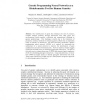Free Online Productivity Tools
i2Speak
i2Symbol
i2OCR
iTex2Img
iWeb2Print
iWeb2Shot
i2Type
iPdf2Split
iPdf2Merge
i2Bopomofo
i2Arabic
i2Style
i2Image
i2PDF
iLatex2Rtf
Sci2ools
GECCO
2004
Springer
2004
Springer
Genetic Programming Neural Networks as a Bioinformatics Tool for Human Genetics
The identification of genes that influence the risk of common, complex diseases primarily through interactions with other genes and environmental factors remains a statistical and computational challenge in genetic epidemiology. This challenge is partly due to the limitations of parametric statistical methods for detecting genetic effects that are dependent solely or partially on interactions. We have previously introduced a genetic programming neural network (GPNN) as a method for optimizing the architecture of a neural network to improve the identification of gene combinations associated with disease risk. Previous empirical studies suggest GPNN has excellent power for identifying gene-gene interactions. The goal of this study was to compare the power of GPNN and stepwise logistic regression (SLR) for identifying gene-gene interactions. Using simulated data, we show that GPNN has higher power to identify gene-gene interactions than SLR. These results indicate that GPNN may be a usefu...
| Added | 01 Jul 2010 |
| Updated | 01 Jul 2010 |
| Type | Conference |
| Year | 2004 |
| Where | GECCO |
| Authors | Marylyn D. Ritchie, Christopher S. Coffey, Jason H. Moore |
Comments (0)

